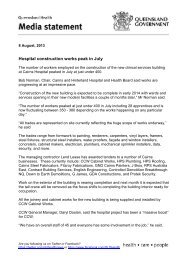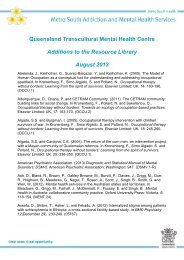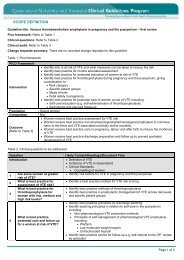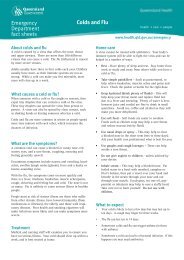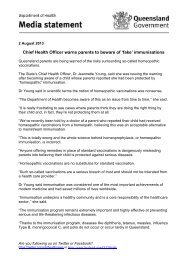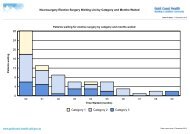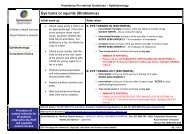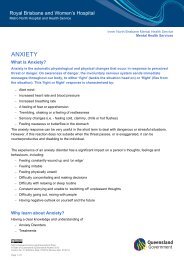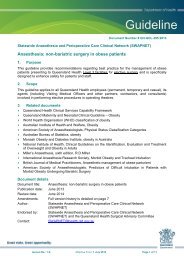Paediatrics - Queensland Health - Queensland Government
Paediatrics - Queensland Health - Queensland Government
Paediatrics - Queensland Health - Queensland Government
Create successful ePaper yourself
Turn your PDF publications into a flip-book with our unique Google optimized e-Paper software.
Respiratory problems<br />
566<br />
Controlled copy V1.0<br />
Croup / epiglottitis<br />
Recommend<br />
Keep the child as calm as possible<br />
Do not examine the mouth or throat and do not lie the child flat<br />
Background<br />
Croup usually follows 3 or 4 days of a mild URTI when the infection spreads to affect<br />
the upper airways; it is usually mild and self limiting<br />
Epiglottitis (cellulitis of the epiglottis) is caused by Haemophilus influenza type B<br />
infection and is fatal if untreated. It is rare since Hib vaccination was introduced<br />
Related topics<br />
Acute upper airway obstruction and choking<br />
1. May present with<br />
• Acute epiglottitis<br />
- - weak or no cough<br />
- - temperaure >38.5°C<br />
-- septicaemia<br />
-- looks sick<br />
- - drooling saliva<br />
-- unable to eat or drink<br />
- - doesn’t talk<br />
- - any age<br />
- - reluctant to move neck<br />
• Croup<br />
- - croupy (barking) cough<br />
- - temperature 95% and consult MO immediately. If >95% not maintained consult<br />
MO. See O 2 delivery systems<br />
• If not tolerated, it is best to interfere with the child as little as possible. Try holding<br />
the O 2 tubing / mask close to face<br />
3. Clinical assessment<br />
• Obtain patient history including onset and preceding URTI<br />
• Perform standard clinical observations. Note in particular, temperature and<br />
respiratory rate (when the child is quiet)<br />
• Inspect for signs of respiratory distress - grunting (stridor), rib or sternal recession,<br />
nasal flaring<br />
• Inspect for drooling in a sick looking child. This along with high fever is suggestive<br />
of epiglottitis<br />
Primary Clinical Care Manual 2011



